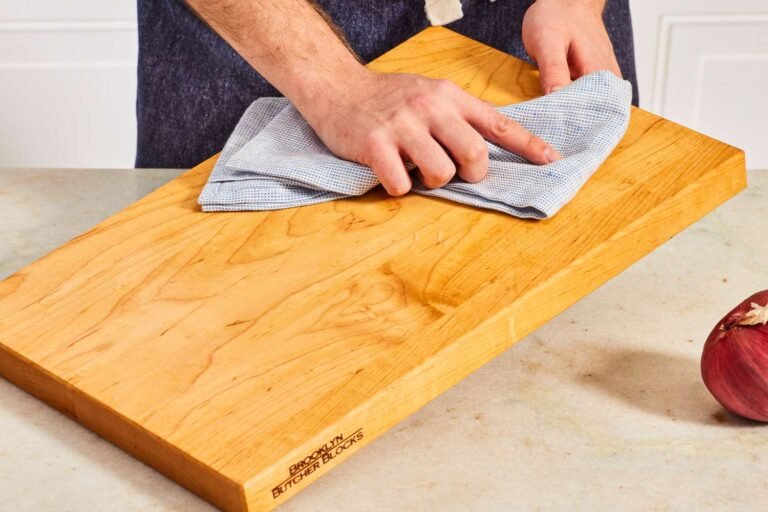Choosing the right wood for your cutting board is more important than you might think. A good cutting board is essential for food prep, protects your knives, and adds a touch of style to your kitchen. The wood you choose affects durability, hygiene, and overall functionality. In this guide, we’ll explore the best woods for cutting boards, what to avoid, and how to care for them so they last for years.
Why Does Wood Matter for Cutting Boards?
When it comes to cutting boards, wood is one of the most popular and trusted materials. But why does the type of wood matter? Not all woods are created equal, and some are far better suited for cutting boards than others. Here’s why wood selection is crucial:
- Durability: The right type of wood can withstand years of knife use without getting damaged or splintering. Hardwoods, in particular, are ideal for this reason.
- Knife-friendliness: A good wood cutting board protects your knives. Softwoods or overly hard woods can either dull your knives quickly or wear out easily.
- Hygiene: Certain woods are naturally antimicrobial and better at resisting bacteria, ensuring your food prep stays safe.
By choosing the best wood for your cutting board, you’ll get a product that’s long-lasting, safe, and easy to maintain.
Top 5 Best Woods for Cutting Boards
The best woods for cutting boards strike the perfect balance between hardness, durability, and ease of maintenance. Here are the top five options:
- Maple (Hard Maple): Hard maple is the gold standard for cutting boards. It’s durable, doesn’t damage knives, and has a fine grain that makes it naturally resistant to bacteria.
- Walnut: Walnut is stylish, durable, and has a slightly softer texture that’s gentle on knives. It’s also known for its beautiful dark brown tones.
- Cherry: Cherry wood is a great option for its striking reddish-brown color and durability. It ages beautifully over time and is gentle on knives.
- Teak: Teak is a water-resistant hardwood that’s ideal for cutting boards. Its natural oils protect it from moisture and bacteria.
- Acacia: Acacia is a budget-friendly and eco-friendly option. It’s a hardwood that’s durable, attractive, and resistant to wear and tear.
Let’s dive deeper into the features of these woods.
Maple: A Kitchen Favorite
Maple, especially hard maple, is the most commonly used wood for cutting boards, and for good reason. It hits the sweet spot between hardness and knife-friendliness. Maple has a closed grain, which means it’s less porous and better at resisting moisture and bacteria than many other woods.

Its natural light color makes it easy to see stains, so you can clean it thoroughly after use. Additionally, hard maple is readily available in North America, making it a sustainable and affordable choice. Whether you’re a home cook or a professional chef, maple cutting boards are a reliable and versatile option.
Walnut: Stylish and Durable
Walnut is not only functional but also incredibly stylish. Known for its rich dark brown tones and unique grain patterns, walnut cutting boards add a touch of elegance to any kitchen. But walnut isn’t just about looks. It’s slightly softer than maple, which makes it gentle on knives while still being durable enough to handle daily use.
One of walnut’s biggest advantages is its natural antimicrobial properties, which help keep bacteria at bay. However, walnut boards require regular maintenance, such as oiling, to preserve their beauty and prevent cracking. If you’re looking for a cutting board that combines style and practicality, walnut is a top contender.
Cherry: Durable and Pretty
Cherry wood offers the perfect blend of durability and aesthetics. Its reddish-brown hues deepen over time, giving it a unique and timeless appearance. Cherry is a hardwood, but it’s not as hard as maple or walnut. This means it’s gentle on your knives while still being tough enough to last for years.
One of the standout features of cherry cutting boards is their smooth surface, which resists stains and scratches. However, like walnut, cherry boards need regular oiling to maintain their finish and prevent warping. If you want a cutting board that looks great and performs well, cherry is an excellent choice.
What Woods Should You Avoid for Cutting Boards?
While many types of wood are suitable for cutting boards, some should be avoided at all costs. Here’s why:
- Softwoods (Pine, Cedar): Softwoods are too soft for cutting boards. They damage easily, splinter, and don’t hold up well under regular use.
- Porous Woods (Oak): While oak is a hardwood, its open grain makes it highly porous, which can trap moisture and harbor bacteria.
- Toxic Woods (Mahogany, Rosewood): Certain exotic woods contain toxic substances or allergens that can be harmful during food prep.
Avoid these woods to ensure your cutting board is safe, durable, and hygienic.
How to Pick the Right Wood for You
Choosing the right wood for your cutting board depends on your needs, budget, and aesthetic preferences. Here are some factors to consider:
- Durability: If you want a board that lasts for years, go for hardwoods like maple, walnut, or cherry.
- Budget: Maple and acacia are affordable options, while walnut and teak tend to be pricier.
- Aesthetics: If you care about how your cutting board looks, choose walnut or cherry for their striking grain patterns.
- Maintenance: If you want a low-maintenance option, look for woods like teak, which naturally resist moisture and bacteria.
Take these factors into account, and you’ll find a cutting board that’s perfect for your kitchen.
How to Take Care of Your Cutting Board
To make your cutting board last, proper care is essential. A well-maintained board not only looks good but also stays safe and functional for years. Here’s how to care for your cutting board:

Regular Cleaning
Clean your cutting board after every use. Use warm, soapy water and a sponge to scrub the surface thoroughly. Avoid soaking your board in water, as this can cause warping and cracking. Once clean, dry it immediately with a towel.
Oil It Monthly
Wood cutting boards need to be oiled regularly to prevent drying and cracking. Use food-grade mineral oil or a specialized cutting board oil. Apply a generous amount to the surface and let it soak in for several hours before wiping off the excess.
Keep It Dry
Moisture is the enemy of wooden cutting boards. Always dry your board thoroughly after cleaning. Store it in a cool, dry place to prevent warping and bacterial growth. Avoid putting it in the dishwasher, as the heat and water can damage the wood.
Why Wooden Cutting Boards Are Better Than Plastic
Wooden cutting boards are superior to plastic for several reasons:
- Durability: Wood lasts longer than plastic, which tends to scar and wear out quickly.
- Hygiene: Studies show that wood has natural antimicrobial properties that make it safer for food prep.
- Eco-friendliness: Wood is a renewable resource, while plastic contributes to environmental waste.
Choosing a wooden cutting board is better for your kitchen, your knives, and the planet.
Thoughts on Choosing the Best Woods
When it comes to cutting boards, there’s no one-size-fits-all solution. The best wood for you depends on your personal preferences and needs. Maple, walnut, and cherry are all excellent options that combine durability, hygiene, and aesthetics. Avoid softwoods and porous woods to ensure your cutting board lasts.
The Bottom Line
Investing in a high-quality wooden cutting board is one of the best decisions you can make for your kitchen. By choosing the right wood, taking proper care of your board, and avoiding low-quality materials, you’ll have a cutting board that lasts for years and enhances your cooking experience. Whether you go for classic maple, stylish walnut, or vibrant cherry, you can’t go wrong with these top choices. Happy chopping!


